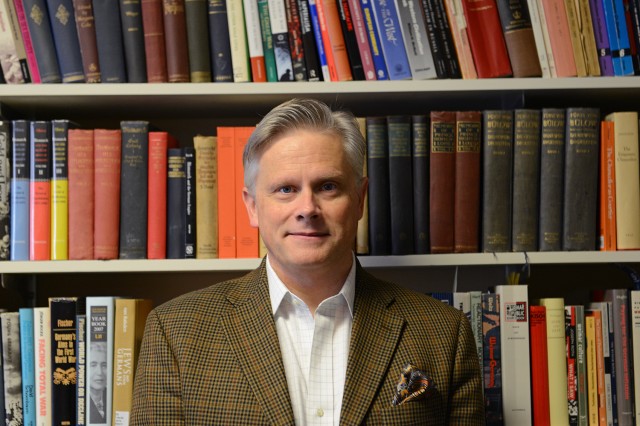Grimmer-Solem’s Research Continues to Have Impact on the Ground in Germany


Associate Professor of History Erik Grimmer-Solem’s research on a celebrated German general, known as an “anti-Nazi,” is continuing to have an impact on the ground in Germany today. Over the past year, Grimmer-Solem’s findings have ignited a public debate in the country over General Hans von Sponeck’s place in history—a debate which has now turned to the matter of a commemorative stone honoring him.
Since World War II, von Sponeck had been celebrated in Germany with an Air Force base, city streets and other monuments named after him. All this has changed since Grimmer-Solem’s research shed new light on the General’s reputation as a “good general” who was court-martialed and imprisoned for refusing to follow Hitler’s orders during a major Soviet counteroffensive on the Crimean Peninsula in 1941 by withdrawing his troops from Kerch, likely saving the lives of thousands of soldiers.
A personal connection involving his grandfather drew Grimmer-Solem to study von Sponeck. A detailed investigation of von Sponeck’s military career in the German Military Archives turned up evidence that the general’s record was far from spotless: The records showed close cooperation between the military unit von Sponeck commanded and the SS in committing numerous war crimes and crimes against humanity in the southern Ukraine and Crimea in 1941.
The research was covered in major German news outlets and sparked a national debate and parliamentary discussion about von Sponeck’s legacy. The latest impact has been on a Stolperstein (German for “stumbling stone”) commemorating von Sponeck. More than 48,000 of these granite cobbles are installed in locations around German cities, each with a brass plaque inscribed with the names and fates of victims of Nazism. According to Grimmer-Solem, while they began as an artist’s project, the Stolpersteine project has taken on a semi-official character in recent years as the stones are set in cooperation with German city governments and supported by many local commemorative and historical societies.
Since last year, the German city of Bremen has been grappling with the question of what to do with the stone honoring von Sponeck—a victim of the Nazis who was also a perpetrator. The stone was first set into the pavement in 2007, before Grimmer-Solem’s findings, published in the peer-reviewed military history journal of the German Armed Forces in December 2013, changed public perception of the General.
“Since then, any official commemoration of Sponeck in Germany has become controversial and has led to a debate about what to do about street names, monuments, and of course, the commemorative Stolperstein,” said Grimmer-Solem. “Sponeck’s Stolperstein is particularly problematic as it erases a line between the victims and perpetrators of the Holocaust,” a point he made in the conclusion of his article.
When Gunter Demnig, the Cologne-based artist behind the Stolpersteine project, learned of Grimmer-Solem’s findings, he demanded that the city of Bremen remove the Stolperstein immediately, or else he would no longer sanction the project in Bremen, the home of more than 600 stones. Removal of the commemorative stone was controversial, however, and Bremen project leaders insisted on a public discussion about the matter.
“As the project has gained popularity and sanction as a semi-official memorial, removing Stolpersteine is awkward new territory lacking precedent let alone any procedures,” Grimmer-Solem explained.
On March 3, the Bremen State Central Office for Political Education hosted a podium discussion titled “Grauzonen. Stolpersteine für Wehrmachtsgenerale” (“Gray Zones: Stumbling Stones for Members of the Wehrmacht.”) It was ultimately agreed that the Stolperstein should be officially removed.
“But, to everyone’s surprise, thieves had beaten them to it,” Grimmer-Solem said. At some point, unknown people had excavated and stolen Sponeck’s Stolperstein, and police are now investigating.
The debate is now extending to the legacy of the German military resistance to Hitler in contemporary Germany. As an editorial in the German newspaper Die Tageszeitung (TAZ) noted recently, the debate about von Sponeck has spread well beyond Bremen and now extends to reassessing such postwar German national icons as Claus von Stauffenberg, who is remembered for his failed assassination attempt on Hitler on July 20, 1944.
“Stauffenberg, too, has a Stolperstein… and he, like many of his military co-conspirators, was involved in war crimes. Sponeck was shot after the failure of the plot, though he did not belong to it—his evolution from perpetrator to victim corresponds exactly to the ambivalence of this group,” the newspaper wrote.
This increasingly critical view of the July 20 conspirators marks a substantial shift in Germany. In the early years of the Federal Republic, Germans found it difficult to honor “traitors” like Stauffenberg, but he took on an increasingly central place in the “democratic” identity of West Germany’s armed forces, and since the 1960s, in German perceptions of themselves as opponents and victims of the Nazi regime.
“It is a sign of the maturity of German democracy that it is now slowly coming to terms with the complex legacy of men like von Stauffenberg,” Grimmer-Solem said.
Read more about Grimmer-Solem’s research on von Sponeck here.

